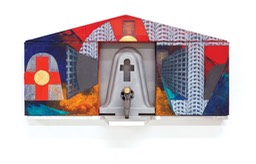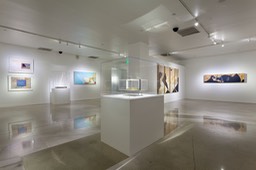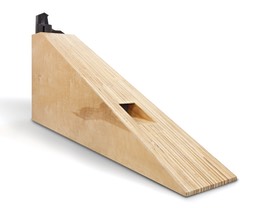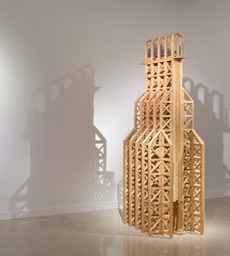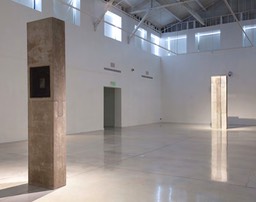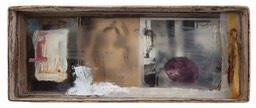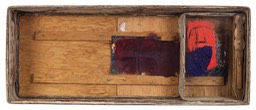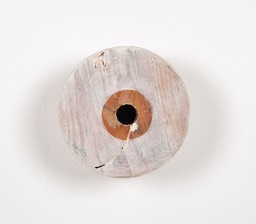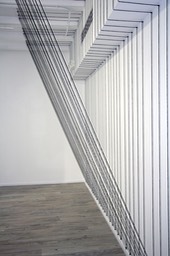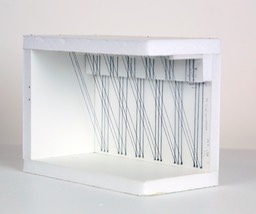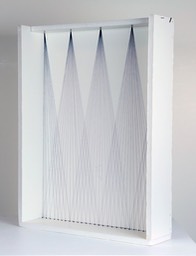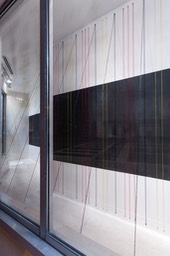Artist and curatorial commentaries on the exhibition
Freedom Tower exhibit traces the artist influence of Robert Thiele and Robert Huff
BY GEORGE FISHMAN
georgefishman@QRartguide.com
Listen to audio: bitly.com/Huff-Thiele
IF YOU GO
What: ‘Robert Huff / 47 Years’ and ‘Untitled (3for8) — Robert Thiele.’
When: Through Nov. 8.
Where: MDC Museum of Art + Design, Freedom Tower at Miami Dade College, 600 Biscayne Blvd.
For info: Call 305-237-7700 or visit mdcmoad.org.
Also on display: ‘Macchietta. Small sketches by Karen Rifas’ through Jan. 31.
In event-driven Miami, “getting people to come to an opening isn’t the challenge,” artist Robert Thiele said. “It’s getting them sufficiently moved that they’ll come back for another look.”
That challenge deserves to be met both for Thiele and former colleague Robert Huff’s parallel exhibition. Sadly, Huff’s work must stand in for his living presence. He died last year.
Solo shows in MOAD’s main galleries invite comparisons, since the artists were friends, instructors at MDC and pioneers in Miami’s evolution as an arts center.
Experienced in the construction trades, both artists excelled in the craft of their art. The exhibitions represent decades of devoted experimentation, and the work straddles disciplines. As Thiele put it, “We're probably the only two people [about whom] you could say ‘Is he a painter? Sort of. Is he a sculptor? Well, yeah.’”
The mastery that characterizes these distinguished and distinct careers underlies their powerful influence as teachers and their impact on pre-Art Basel Miami. MOAD director Jeremy Mikolajczak wanted to explore the groundwork behind later generations of artists with South Florida roots now garnering deserved attention.
“The college has been educating artists since the 1960s, and teaching artists like Huff and Thiele have been instrumental. But they never really got the credit they deserve as artists making a stamp within this community,” he said.
And rather than spawn “Hufflets” or “Thiele juniors,” their influence inspired younger artists’ commitment to seriously explore and challenge their own hearts and minds. The legacy also includes MDC’s irreplaceable permanent collection, which Huff, Thiele and Robert Sindelir (former MDC galleries director) initiated while serving administrative roles. Additionally, Thiele’s North Miami building houses other artists’ studios and vital exhibition spaces Bridge Red and Under the Bridge.
ROBERT THIELE
He thinks of himself first as a painter, but his process of obscuring and revealing surfaces, spaces and meanings is that of a sculptor, unafraid to cannibalize. “If a painting doesn't work, that's the beginning, more often than not. So, then I have the option … of cutting into it, cutting it up, turning it around, using another painting, adding to it,” he said. The work becomes three-dimensional. Small, reliquary-like windows penetrate many of Thiele’s sculptures; they are made in advance of the concrete forms that sometimes carry them. The fabrication is a rigorous workman-like process, and Thiele’s studio looks like a construction workshop.
I've always worked with tools,” he said. “When I was in high school I worked for a curb and gutter contractor, and I was a cement finisher. So, when I started making the objects with glass on both sides, I went to concrete as a material I knew how to work with.” Like an Eskimo knows snow, Thiele knows concrete. That mastery encompasses his complex interlocking concrete forms as well as subtle surface variations he achieves combining paint, wood, resin and fabric.
An arts career wasn’t his first choice. While a social-sciences major at Kent State University, a friend’s casual invitation led Thiele to a carving class. “I dropped everything else and graduated with an MFA in sculpture and a BFA in painting,” he said. “Yes, that was my road to Damascus.”
A 1966 invitation brought him to Miami-Dade Community College’s nascent art program, where he taught until about 10 years ago. He has maintained studios for 30 years, migrating to Brooklyn during recent summers.
Teaching freed Thiele to change course following another “Damascus” experience. While he produced a successful series of geometric-shaped paintings, he found his young children, Kyle and Kristen, rolling up scraps of canvas. “Their noodling about with my studio detritus,” he realized, “was more interesting and more personal and more compelling and more open-ended and more magical than what I was laboring on with these design projects. It was almost that quick. It was almost, like, ‘Well maybe I'm going to roll some canvas up. Maybe I'll just attach something of mine,’ and… all of a sudden they're behind glass and all of a sudden there are all kinds of things happening. It was like a reservoir had broken, and everything flowed through.”
That flow through is sometimes literal. Bakaty from 1990 evokes peering into the windows of a boarded-up house. Viewable from front and back, it presents reflections, curtains and veils that rebuff, but also areas of unobscured glazing that permit entry into “rooms” within and surfaces that evidence repeated reworking.
Thiele’s experimental interventions may take years to achieve. “I can start maybe with a photograph, then I bury it under multiple layers; I have an obstruction in front of it. I can paint over it partially and the final layer is acid etched acrylic sheet, which blurs it further.”
When Thiele first considered the exhibition space with guest curator Tyler Emerson, co-director of Emerson-Dorsch Gallery, they found it daunting. “It sort of looks like an airport hangar,” he said. Emerson explained their approach. “We were literally looking down at the floor plan in the same way that he looks at making a single piece. He's thinking about form and symmetry.”
Their installation evokes a Gothic cathedral with two imposing concrete towers effectively commanding the soaring space. “The larger concrete pieces become pillars,” said Emerson, “that are the supports or the body for these windows that could be the soul or head – to be anthropomorphic.” A transept-like “aisle” intersects perpendicularly, and two windowed concrete forms face off across a wide span.
The narrow side galleries contain additional free-standing windowed works and “string courses” of football-sized, variously shaped wall-mounted pieces, arranged not chronologically, but by rhythms of form and surface treatment: overpainting, scraping, diagramming, incising. All retain the Kyle-and-Kristen-inspired canvas wrapping and suggest infinite possible variation – “like any poetic form or musical form,” suggested Emerson.
“We have a noisy space and we’re going to quiet it down in terms of the work,” said Thiele before the installation. That meditative aura is reinforced by an audio component developed by veteran sound artists Gustavo Matamoros and René Barge. They sonically analyzed the natural resonance of one side gallery, so they could generate specific frequencies that the room “likes.” They repeated the process with Thiele’s bronze sculptures, Vienna Venus I and II, that face one another. By attaching electronically activated, vibrating transducers, they treat the sculptures like tuning forks. “We’re causing the bronze to produce a sound that the room likes, and the room reinforces and amplifies it,” Matamoros said.
ROBERT HUFF
Robert Huff shared Thiele’s experimental and workman-like orientation. He equipped his studio with machine tools suitable for sculpture or furniture building. That orientation came naturally. He worked construction from an early age under tutelage from his father and uncle. “Tools were always around; people were always doing things with tools," said his widow, Barbara Young. “He was very physically involved with materials, with tools and things like that and also with the natural world.” That ability to “think with his hands” eventually allowed him to skip the common practice of preliminary sketching, and to progress directly from building one piece to building the next.
While attending the University of South Florida, Huff also had a “conversion experience.” After a profoundly moving encounter with a small Monet painting he switched majors from engineering to art, eventually incorporating sculpture, printmaking and photography in his MFA show. He graduated in 1968 and got a job at Miami Dade College, where he worked tirelessly until 2005.
Carol Jazzar, guest curator for the Huff exhibition, selected insightfully from his 47 years of production. She followed the logic of chronology in the catalog, but “the space pretty much determined the placement of the work in the gallery,” she said. Concept, form and color guide the viewer; key works mark series transitions and reveal the artist’s evolution and passions.
When he moved to Miami, the Everglades became a haunt where Huff could fish, while absorbing textures and light. Through an abstracting filter and eye for pattern, his early paintings, drawings and sculptures intermingle sky/water reflections, clouds and such human constructs as nautical charts, balcony railings and cupolas.
“He was a landscape person, but there are a lot of verticals in the landscape, and a lot of times those are architectural structures, like houses or buildings or towers or old chimneys. You see a little roofline in a number of pieces and the grid pattern repeated,” said Young.
Grids function as patterning, but also illusionistically as openings and barriers, appearing as cylinders or as openings to internal spaces. Brightly painted wall constructions from the 1980s and '90s reflect an influential sojourn to Russia, from which Huff adopted a dramatic application of gold leaf over red. Pete’s Pulley combines textured and flat geometric painting with subtly rendered buoy or chimney forms – bisected by an aluminum sheet, pipe and pulley. Its taut balance of seemingly disparate elements is arresting. Other works incorporate wheels, tracks, grates - even a pistol.
In Sidh Study 12.96, grid-shaped perforations allow both light and the viewer’s gaze to penetrate a bronze house-like form, perched atop an eight-foot-long laminated wooden wedge. In a 2014 interview with esteemed critic Helen Kohen, Huff said, “Metals, which a lot of people think of as rigid and resilient and cold, to me they are fluid.” About grids: “They’re spatial; they can define a space without actually occupying it. They’re structural, and I think structurally.”
Titan is an intricately constructed wooden trestle form that resembles the Virginia coal elevators, where Huff and Young purchased property. It’s also church-like, and Young noted that, “Coal is almost like a religion up there.” Huff resisted literal interpretations, but Jazzar suggests his later delicate drawings and boldly inventive paintings on oriented strand board (a kind of patterned plywood) convey – with both power and beauty – his passionate critique of mining’s desecration.
Collecting and tinkering with found objects – large and small – often contributed to his process. Floridascape, from 1973, is a small, but complex sculpture. Chromed tubes elevate a rectangular Plexiglas box above a reflective slab. A curious assortment of small, brightly colored objects inhabits the box, which is penetrated by curvilinear wires. But for Huff, boxes were not simply containers; they generate complex shadows and serve as a surface for delicate print transfers.
KAREN RIFAS
Delicacy and precision characterize Karen Rifas’ compact show of maquettes that inaugurates MOAD’s new Design Lab, created to study the connections between art and design. The exhibition represents 19 years of Rifas’ signature work – in miniature. Before developing her practice of marking architectural interiors with arrays of cords and strings – occasionally threading native oak leaves – Rifas explored various two and three-dimensional mediums. She welded, worked with resin, drew, painted and built Plexi boxes in Huff’s classes before earning an MFA at the University of Miami.
Those experiences developed her spatial awareness and prepared her to build scale models to study her intended site installations. “My work is about understanding space – imagining, utilizing it and enhancing it,” she said. Huff remained her friend and mentor.
In her neatly boxed maquettes, she previews a real or imagined room, alcove or passageway, then precisely fixes parallel threads to create complex patterns that follow or intersect its surfaces and spaces. “In my work I try to encompass. It doesn’t take a whole lot. It’s minimalism – just a few correct things … where I want people to walk through and feel the space,” she said. “When I use color I’m satisfied to just use a few.”
Rifas admires Thiele’s ability to generate an occupying presence with his sculpture, but her approach is different: “I’m more a reductive person, [rather] than adding and adding, I find a minimal way to explain the space.”
